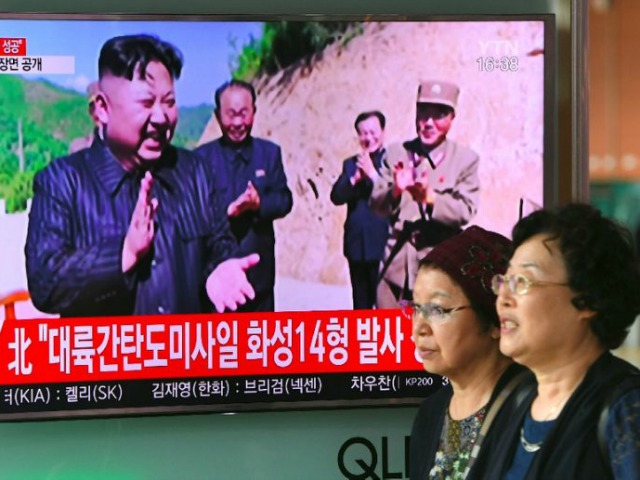North Korea’s state media announced Friday that the country has issued a new set of stamps to commemorate the testing of an intercontinental ballistic missile (ICBM) in July, yet another sign the nation’s communist regime remains unapologetic about its belligerent threats to its neighbors and the United States.
The stamps feature dictator Kim Jong-un as well as the weapons in question, a celebration of the nation’s illegal nuclear weapon’s program. North Korea often issues special edition stamps to commemorate milestones for its nuclear program and key anniversaries in the history of the repressive Kim family cult.
Rodong Sinmun, the state newspaper, describes one new stamp as featuring “an image of respected Supreme Leader Kim Jong-un among soldiers in the field of national defence science who successfully conducted the second ICBM test-launch on its center surrounded by pictures of the fluttering WPK flag and the ICBM soaring into the dark sky leaving a column of flames behind.”
The other stamp, which it displays on the page, “shows that the invincible mightiness and inexhaustible potentials of Juche Korea advancing under the banner of the new line of the great WPK for simultaneously developing the two fronts have been strikingly displayed once again,” according to the newspaper.
The stamp is meant to show “the boom of victory” against America:

The Hwasong-14 missile test in question occurred on July 4, in an apparent attempt to provoke the United States on its Independence Day. Experts concluded from the missile’s trajectory that it was in fact an ICBM, and could potentially reach Alaska. North Korea has not yet succeeded in properly miniaturizing a nuclear warhead to place on such a missile, but when it does it could potentially strike the United States with a nuclear bomb.
North Korea once against tested a missile on the week of July 28, confirmed by the Pentagon as an ICBM in a subsequent press conference. The missile fell into the Sea of Japan. As North Korea tends to schedule such launches around meaningful dates, this launch occurred following the celebration of North Korea’s “Victory Day,” which observes the end of hostilities during the Korean War. As the United States and North Korea have never signed a peace treaty, the Korean War never officially ended.
North Korea also typically issues postage stamps promoting war with the United States. In July, following the ICBM test, Pyongyang debuted a series of stamps to celebrate “Struggle Against U.S. Imperialism Month” featuring illustrations of attacks on the U.S. Capitol and other Washington hallmarks, as well as the destruction of the American flag.
This week, North Korea tested yet another missile, this time flying it over Japanese territory, alarming Tokyo. The missile flew over the northernmost island of Hokkaido and collapsed over the Pacific Ocean. After receiving global condemnation, the Kim regime responded with a series of typically vitriolic articles condemning the United States and vowing to bring about “nuclear criminal” America’s “final doom.”
North Korea also regularly threatens nuclear attacks on Washington, D.C., New York, and California in propaganda videos broadcast throughout the country. It has explicitly rejected dialogue with the United States or South Korea on abiding by United Nations denuclearization protocol and repeatedly ignored UN sanctions.
On Thursday, following months of attempting to further engage China in attempting to curb its allies in Pyongyang, American President Donald Trump lamented North Korea’s refusal to engage in sensible diplomacy with the rest of the world. “The U.S. has been talking to North Korea, and paying them extortion money, for 25 years,” Trump wrote on Twitter. “Talking is not the answer!”

COMMENTS
Please let us know if you're having issues with commenting.